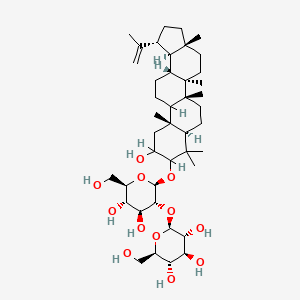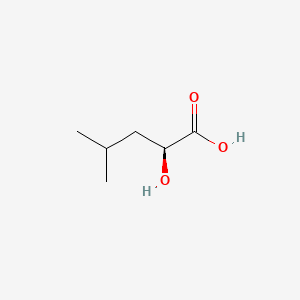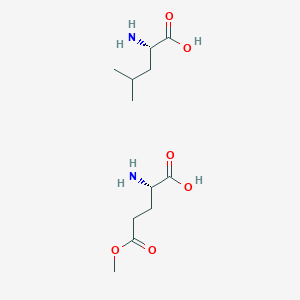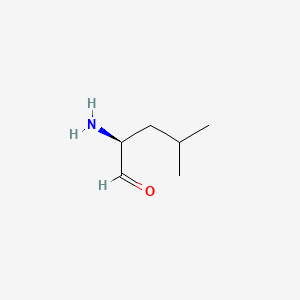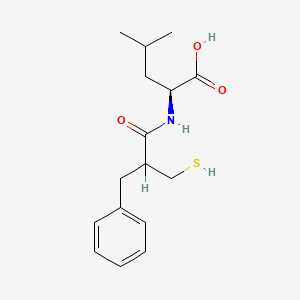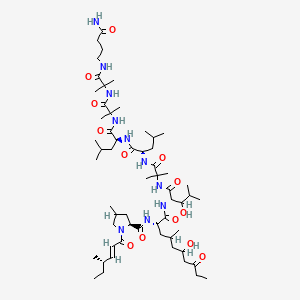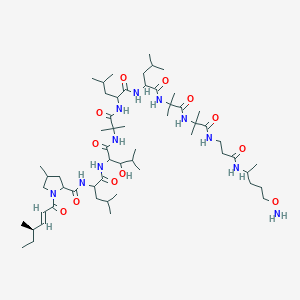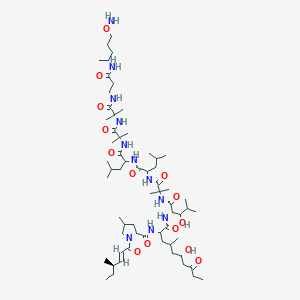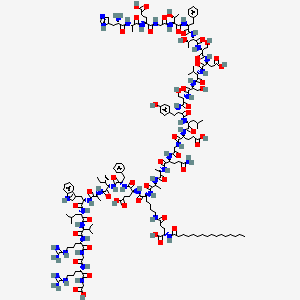
リラグルチド
説明
作用機序
リラグルチドは、グルカゴン様ペプチド-1受容体の作動薬として作用することで効果を発揮します . この受容体は、インスリン分泌、グルカゴン放出、食欲の調節に関与しています . この受容体を活性化することにより、リラグルチドはインスリン分泌を促進し、グルカゴン放出を抑制し、胃の排泄を遅らせ、食物摂取を減らします .
類似の化合物との比較
類似の化合物
セマグルチド: 同様の適応症で使用される別のグルカゴン様ペプチド-1受容体作動薬.
エキセナチド: 短時間作用型のグルカゴン様ペプチド-1受容体作動薬.
デュラグルチド: 長時間作用型のグルカゴン様ペプチド-1受容体作動薬.
ユニークさ
リラグルチドは、1日1回の投与と、血糖コントロールの改善に加えて体重を大幅に減らすことができる点が特徴です . 他のグルカゴン様ペプチド-1受容体作動薬とは異なり、リラグルチドは心血管系への有益な効果を示すことが示されています .
科学的研究の応用
Liraglutide has a wide range of scientific research applications:
Chemistry: Used as a model peptide for studying peptide synthesis and modification techniques.
Biology: Investigated for its role in regulating glucose metabolism and appetite.
Medicine: Extensively studied for its therapeutic effects in type 2 diabetes and obesity.
Industry: Used in the development of new peptide-based therapeutics.
生化学分析
Biochemical Properties
Liraglutide plays a significant role in biochemical reactions. It interacts with various enzymes, proteins, and other biomolecules. For instance, it has been found to interact with glucagon-like peptide 1 receptor (GLP-1R), which is a G protein-coupled receptor . The nature of these interactions involves binding to the receptor, which triggers a series of biochemical reactions leading to the secretion of insulin .
Cellular Effects
Liraglutide has profound effects on various types of cells and cellular processes. It influences cell function by impacting cell signaling pathways, gene expression, and cellular metabolism. For instance, it has been found to preserve pancreatic beta cells via regulation of cell kinetics and suppression of oxidative and endoplasmic reticulum stress in a mouse model of diabetes .
Molecular Mechanism
The mechanism of action of Liraglutide is quite complex. It exerts its effects at the molecular level through binding interactions with biomolecules, enzyme inhibition or activation, and changes in gene expression. For instance, it binds to the GLP-1R, which leads to the activation of adenylyl cyclase and an increase in cyclic AMP levels .
Temporal Effects in Laboratory Settings
In laboratory settings, the effects of Liraglutide change over time. It has been found to have a half-life of more than 13 hours, indicating its stability . Long-term effects on cellular function observed in in vitro or in vivo studies include improved insulin sensitivity and glucose homeostasis .
Dosage Effects in Animal Models
The effects of Liraglutide vary with different dosages in animal models. For instance, in db/db mice, Liraglutide treatment improved metabolic variables and insulin sensitivity .
Metabolic Pathways
Liraglutide is involved in several metabolic pathways. It interacts with enzymes such as adenylyl cyclase and influences metabolic flux and metabolite levels .
Transport and Distribution
Liraglutide is transported and distributed within cells and tissues. It is administered as an isotonic solution by subcutaneous injection .
Subcellular Localization
Given its role in activating the GLP-1R, it is likely that it is localized to the cell membrane where this receptor is found .
準備方法
合成経路と反応条件
リラグルチドは、ペプチド前駆体の26位のリジン残基にグルタミン酸スペーサーを介してC-16脂肪酸(パルミチン酸)を結合させることによって合成されます . 合成には、アミノ酸が固体樹脂に固定された成長中のペプチド鎖に順次添加される固相ペプチド合成技術が使用されます . 最終生成物はその後、樹脂から切断され、高速液体クロマトグラフィーを使用して精製されます .
工業的生産方法
リラグルチドの工業的生産には、大規模な固相ペプチド合成と、それに続くクロマトグラフィー技術による精製が含まれます . このプロセスは、最終生成物の高収率と純度を確保するために最適化されており、これは治療効果にとって不可欠です .
化学反応の分析
反応の種類
リラグルチドは、次のようなさまざまな化学反応を起こします。
一般的な試薬と条件
生成される主な生成物
これらの反応から生成される主な生成物には、酸化または還元されたリラグルチドが含まれ、薬理学的特性が異なる場合があります .
科学研究への応用
リラグルチドには、広範な科学研究への応用があります。
類似化合物との比較
Similar Compounds
Semaglutide: Another glucagon-like peptide-1 receptor agonist used for similar indications.
Exenatide: A shorter-acting glucagon-like peptide-1 receptor agonist.
Dulaglutide: A long-acting glucagon-like peptide-1 receptor agonist.
Uniqueness
Liraglutide is unique due to its once-daily dosing regimen and its ability to significantly reduce body weight in addition to improving glycemic control . Unlike some other glucagon-like peptide-1 receptor agonists, liraglutide has been shown to have beneficial effects on cardiovascular outcomes .
特性
IUPAC Name |
(2S)-5-[[(5S)-5-[[(2S)-2-[[(2S)-2-[[(2S)-5-amino-2-[[2-[[(2S)-2-[[(2S)-2-[[(2S)-2-[[(2S)-2-[[(2S)-2-[[(2S)-2-[[(2S)-2-[[(2S)-2-[[(2S,3R)-2-[[(2S)-2-[[(2S,3R)-2-[[2-[[(2S)-2-[[(2S)-2-[[(2S)-2-amino-3-(1H-imidazol-5-yl)propanoyl]amino]propanoyl]amino]-4-carboxybutanoyl]amino]acetyl]amino]-3-hydroxybutanoyl]amino]-3-phenylpropanoyl]amino]-3-hydroxybutanoyl]amino]-3-hydroxypropanoyl]amino]-3-carboxypropanoyl]amino]-3-methylbutanoyl]amino]-3-hydroxypropanoyl]amino]-3-hydroxypropanoyl]amino]-3-(4-hydroxyphenyl)propanoyl]amino]-4-methylpentanoyl]amino]-4-carboxybutanoyl]amino]acetyl]amino]-5-oxopentanoyl]amino]propanoyl]amino]propanoyl]amino]-6-[[(2S)-1-[[(2S)-1-[[(2S,3S)-1-[[(2S)-1-[[(2S)-1-[[(2S)-1-[[(2S)-1-[[(2S)-5-carbamimidamido-1-[[2-[[(2S)-5-carbamimidamido-1-(carboxymethylamino)-1-oxopentan-2-yl]amino]-2-oxoethyl]amino]-1-oxopentan-2-yl]amino]-3-methyl-1-oxobutan-2-yl]amino]-4-methyl-1-oxopentan-2-yl]amino]-3-(1H-indol-3-yl)-1-oxopropan-2-yl]amino]-1-oxopropan-2-yl]amino]-3-methyl-1-oxopentan-2-yl]amino]-1-oxo-3-phenylpropan-2-yl]amino]-4-carboxy-1-oxobutan-2-yl]amino]-6-oxohexyl]amino]-2-(hexadecanoylamino)-5-oxopentanoic acid | |
|---|---|---|
| Source | PubChem | |
| URL | https://pubchem.ncbi.nlm.nih.gov | |
| Description | Data deposited in or computed by PubChem | |
InChI |
InChI=1S/C172H265N43O51/c1-18-20-21-22-23-24-25-26-27-28-29-30-37-53-129(224)195-116(170(265)266)59-64-128(223)180-68-41-40-50-111(153(248)199-115(62-67-135(232)233)154(249)204-120(73-100-44-33-31-34-45-100)159(254)214-140(93(11)19-2)167(262)192-97(15)146(241)201-122(76-103-79-183-108-49-39-38-48-106(103)108)157(252)203-118(72-90(5)6)158(253)212-138(91(7)8)165(260)200-110(52-43-70-182-172(177)178)149(244)184-81-130(225)193-109(51-42-69-181-171(175)176)148(243)187-84-137(236)237)196-144(239)95(13)189-143(238)94(12)191-152(247)114(58-63-127(174)222)194-131(226)82-185-151(246)113(61-66-134(230)231)198-155(250)117(71-89(3)4)202-156(251)119(75-102-54-56-105(221)57-55-102)205-162(257)124(85-216)208-164(259)126(87-218)209-166(261)139(92(9)10)213-161(256)123(78-136(234)235)206-163(258)125(86-217)210-169(264)142(99(17)220)215-160(255)121(74-101-46-35-32-36-47-101)207-168(263)141(98(16)219)211-132(227)83-186-150(245)112(60-65-133(228)229)197-145(240)96(14)190-147(242)107(173)77-104-80-179-88-188-104/h31-36,38-39,44-49,54-57,79-80,88-99,107,109-126,138-142,183,216-221H,18-30,37,40-43,50-53,58-78,81-87,173H2,1-17H3,(H2,174,222)(H,179,188)(H,180,223)(H,184,244)(H,185,246)(H,186,245)(H,187,243)(H,189,238)(H,190,242)(H,191,247)(H,192,262)(H,193,225)(H,194,226)(H,195,224)(H,196,239)(H,197,240)(H,198,250)(H,199,248)(H,200,260)(H,201,241)(H,202,251)(H,203,252)(H,204,249)(H,205,257)(H,206,258)(H,207,263)(H,208,259)(H,209,261)(H,210,264)(H,211,227)(H,212,253)(H,213,256)(H,214,254)(H,215,255)(H,228,229)(H,230,231)(H,232,233)(H,234,235)(H,236,237)(H,265,266)(H4,175,176,181)(H4,177,178,182)/t93-,94-,95-,96-,97-,98+,99+,107-,109-,110-,111-,112-,113-,114-,115-,116-,117-,118-,119-,120-,121-,122-,123-,124-,125-,126-,138-,139-,140-,141-,142-/m0/s1 | |
| Source | PubChem | |
| URL | https://pubchem.ncbi.nlm.nih.gov | |
| Description | Data deposited in or computed by PubChem | |
InChI Key |
YSDQQAXHVYUZIW-QCIJIYAXSA-N | |
| Source | PubChem | |
| URL | https://pubchem.ncbi.nlm.nih.gov | |
| Description | Data deposited in or computed by PubChem | |
Canonical SMILES |
CCCCCCCCCCCCCCCC(=O)NC(CCC(=O)NCCCCC(C(=O)NC(CCC(=O)O)C(=O)NC(CC1=CC=CC=C1)C(=O)NC(C(C)CC)C(=O)NC(C)C(=O)NC(CC2=CNC3=CC=CC=C32)C(=O)NC(CC(C)C)C(=O)NC(C(C)C)C(=O)NC(CCCNC(=N)N)C(=O)NCC(=O)NC(CCCNC(=N)N)C(=O)NCC(=O)O)NC(=O)C(C)NC(=O)C(C)NC(=O)C(CCC(=O)N)NC(=O)CNC(=O)C(CCC(=O)O)NC(=O)C(CC(C)C)NC(=O)C(CC4=CC=C(C=C4)O)NC(=O)C(CO)NC(=O)C(CO)NC(=O)C(C(C)C)NC(=O)C(CC(=O)O)NC(=O)C(CO)NC(=O)C(C(C)O)NC(=O)C(CC5=CC=CC=C5)NC(=O)C(C(C)O)NC(=O)CNC(=O)C(CCC(=O)O)NC(=O)C(C)NC(=O)C(CC6=CN=CN6)N)C(=O)O | |
| Source | PubChem | |
| URL | https://pubchem.ncbi.nlm.nih.gov | |
| Description | Data deposited in or computed by PubChem | |
Isomeric SMILES |
CCCCCCCCCCCCCCCC(=O)N[C@@H](CCC(=O)NCCCC[C@@H](C(=O)N[C@@H](CCC(=O)O)C(=O)N[C@@H](CC1=CC=CC=C1)C(=O)N[C@@H]([C@@H](C)CC)C(=O)N[C@@H](C)C(=O)N[C@@H](CC2=CNC3=CC=CC=C32)C(=O)N[C@@H](CC(C)C)C(=O)N[C@@H](C(C)C)C(=O)N[C@@H](CCCNC(=N)N)C(=O)NCC(=O)N[C@@H](CCCNC(=N)N)C(=O)NCC(=O)O)NC(=O)[C@H](C)NC(=O)[C@H](C)NC(=O)[C@H](CCC(=O)N)NC(=O)CNC(=O)[C@H](CCC(=O)O)NC(=O)[C@H](CC(C)C)NC(=O)[C@H](CC4=CC=C(C=C4)O)NC(=O)[C@H](CO)NC(=O)[C@H](CO)NC(=O)[C@H](C(C)C)NC(=O)[C@H](CC(=O)O)NC(=O)[C@H](CO)NC(=O)[C@H]([C@@H](C)O)NC(=O)[C@H](CC5=CC=CC=C5)NC(=O)[C@H]([C@@H](C)O)NC(=O)CNC(=O)[C@H](CCC(=O)O)NC(=O)[C@H](C)NC(=O)[C@H](CC6=CN=CN6)N)C(=O)O | |
| Source | PubChem | |
| URL | https://pubchem.ncbi.nlm.nih.gov | |
| Description | Data deposited in or computed by PubChem | |
Molecular Formula |
C172H265N43O51 | |
| Source | PubChem | |
| URL | https://pubchem.ncbi.nlm.nih.gov | |
| Description | Data deposited in or computed by PubChem | |
DSSTOX Substance ID |
DTXSID60174433 | |
| Record name | Liraglutide | |
| Source | EPA DSSTox | |
| URL | https://comptox.epa.gov/dashboard/DTXSID60174433 | |
| Description | DSSTox provides a high quality public chemistry resource for supporting improved predictive toxicology. | |
Molecular Weight |
3751 g/mol | |
| Source | PubChem | |
| URL | https://pubchem.ncbi.nlm.nih.gov | |
| Description | Data deposited in or computed by PubChem | |
Mechanism of Action |
Liraglutide is an acylated synthetic glucagon-like peptide-1 analog. Liraglutide is an agonist of the glucagon-like peptide-1 receptor which is coupled to adenylate cyclase. The increase in cyclic AMP stimulates the glucose dependant release of insulin, inhibits the glucose dependant release of glucagon, and slows gastric emptying to increase control of blood sugar., Liraglutide is an acylated, long-acting, human glucagon-like peptide-1 (GLP-1) receptor agonist; the synthetic (recombinant DNA origin) peptide precursor of liraglutide has 97% amino acid sequence homology to endogenous human GLP-1-(7-37). Liraglutide is prepared by attaching palmitic acid with a glutamic acid spacer on the lysine residue at position 26 of the peptide precursor. GLP-1-(7-37) represents less than 20% of total circulating endogenous GLP-1. Like GLP-1-(7-37), liraglutide activates the GLP-1 receptor in pancreatic beta cells. Liraglutide also increases intracellular cyclic 3',5'-adenosine monophosphate (cAMP) leading to insulin release in the presence of elevated glucose concentrations. This insulin secretion subsides as blood glucose concentrations decrease and approach euglycemia. In addition, liraglutide suppresses glucagon secretion in a glucose-dependent manner but does not impair normal glucagon response to hypoglycemia. Liraglutide delays gastric emptying, reducing the rate at which postprandial glucose appears in the circulation. As a result of these actions resulting in increased insulin secretion, suppression of glucagon secretion, and delays in gastric emptying, liraglutide effectively reduces fasting and postprandial plasma glucose concentrations in patients with type 2 diabetes mellitus., Liraglutide is a glucagon-like peptide-1 (GLP-1) mimetic used for the treatment of Type 2 diabetes. Similar to the actions of endogenous GLP-1, liraglutide potentiates the post-prandial release of insulin, inhibits glucagon release and increases satiety. Recent epidemiological studies and clinical trials have suggested that treatment with GLP-1 mimetics may also diminish the risk of cardiovascular disease in diabetic patients. The mechanism responsible for this effect has yet to be determined; however, one possibility is that they might do so by a direct effect on vascular endothelium. Since low grade inflammation of the endothelium is an early event in the pathogenesis of atherosclerotic cardiovascular disease (ASCVD), we determined the effects of liraglutide on inflammation in cultured human aortic endothelial cells (HAECs). Liraglutide reduced the inflammatory responses to TNFalpha and LPS stimulation, as evidenced by both reduced protein expression of the adhesion molecules VCAM-1 and E-Selectin, and THP-1 monocyte adhesion. This was found to result from increased cell Ca2+ and several molecules sensitive to Ca2+ with known anti inflammatory actions in endothelial cells, including CaMKKbeta, CaMKI, AMPK, eNOS and CREB. Treatment of the cells with STO-609, a CaMKK inhibitor, diminished both the activation of AMPK, CaMKI and the inhibition of TNFa and LPS-induced monocyte adhesion by liraglutide. Likewise, expression of an shRNA against AMPK nullified the anti-inflammatory effects of liraglutide. The results indicate that liraglutide exerts a strong anti-inflammatory effect on HAECs. They also demonstrate that this is due to its ability to increase intracellular Ca2+ and activate CAMKKbeta, which in turn activates AMPK., In vivo, liraglutide lowers blood glucose and body weight in a number of diabetic and obese models using rodents, pigs and monkeys. The mechanism of action in vivo involved glucose-dependent increase in insulin secretion, lowered glucagon secretion, decreased gastric emptying, loss of body fat, lowered food intake, altered food preference, and maintained energy expenditure. The mechanism of action is consistent with a specific GLP-1 effect., Liraglutide is a long-acting GLP-1 analogue, designed to bind to albumin as the main molecular mechanism of protraction. In vitro, this was shown in the receptor cAMP as well as binding assay where addition of albumin right-shifted the dose-response and/or binding curve. The apparent reduced potency of liraglutide underlines that only the free fraction of liraglutide is responsible for its pharmacological effect in vitro as well as in vivo. Furthermore, liraglutide in a pharmaceutical solution forms a micell-like heptamer which may contribute to the slow absorption from the subcutis. | |
| Record name | Liraglutide | |
| Source | DrugBank | |
| URL | https://www.drugbank.ca/drugs/DB06655 | |
| Description | The DrugBank database is a unique bioinformatics and cheminformatics resource that combines detailed drug (i.e. chemical, pharmacological and pharmaceutical) data with comprehensive drug target (i.e. sequence, structure, and pathway) information. | |
| Explanation | Creative Common's Attribution-NonCommercial 4.0 International License (http://creativecommons.org/licenses/by-nc/4.0/legalcode) | |
| Record name | Liraglutide | |
| Source | Hazardous Substances Data Bank (HSDB) | |
| URL | https://pubchem.ncbi.nlm.nih.gov/source/hsdb/8205 | |
| Description | The Hazardous Substances Data Bank (HSDB) is a toxicology database that focuses on the toxicology of potentially hazardous chemicals. It provides information on human exposure, industrial hygiene, emergency handling procedures, environmental fate, regulatory requirements, nanomaterials, and related areas. The information in HSDB has been assessed by a Scientific Review Panel. | |
CAS No. |
204656-20-2 | |
| Record name | Liraglutide [USAN:INN:BAN:JAN] | |
| Source | ChemIDplus | |
| URL | https://pubchem.ncbi.nlm.nih.gov/substance/?source=chemidplus&sourceid=0204656202 | |
| Description | ChemIDplus is a free, web search system that provides access to the structure and nomenclature authority files used for the identification of chemical substances cited in National Library of Medicine (NLM) databases, including the TOXNET system. | |
| Record name | Liraglutide | |
| Source | DrugBank | |
| URL | https://www.drugbank.ca/drugs/DB06655 | |
| Description | The DrugBank database is a unique bioinformatics and cheminformatics resource that combines detailed drug (i.e. chemical, pharmacological and pharmaceutical) data with comprehensive drug target (i.e. sequence, structure, and pathway) information. | |
| Explanation | Creative Common's Attribution-NonCommercial 4.0 International License (http://creativecommons.org/licenses/by-nc/4.0/legalcode) | |
| Record name | Liraglutide | |
| Source | EPA DSSTox | |
| URL | https://comptox.epa.gov/dashboard/DTXSID60174433 | |
| Description | DSSTox provides a high quality public chemistry resource for supporting improved predictive toxicology. | |
| Record name | Liraglutide (2S)-5-[[(5S)-5-[[(2S)-2-[[(2S)-2-[[(2S)-5-amino-2-[[2-[[(2S)-2-[[(2S)-2-[[(2S)-2-[[(2S)-2-[[(2S)-2-[[(2S)-2- [[(2S)-2-[[(2S)-2-[[(2S,3R)-2-[[(2S)-2-[[(2S,3R)-2-[[2-[[(2S)-2-[[(2S)-2-[[(2S)-2-amino-3-(1H-imidazol-5-yl) propanoyl]amino]propanoyl]amino]-4-carboxybutanoyl]amino]acetyl]amino]-3-hydroxybutanoyl]amino]-3- phenylpropanoyl]amino]-3-hydroxybutanoyl]amino]-3-hydroxypropanoyl]amino]-3-carboxypropanoyl]amino]- 3-methylbutanoyl]amino]-3-hydroxypropanoyl]amino]-3-hydroxypropanoyl]amino]-3-(4-hydroxyphenyl) propanoyl]amino]-4-methylpentanoyl]amino]-4-carboxybutanoyl]amino]acetyl]amino] 5 oxopentanoyl]amino] propanoyl]amino]propanoyl]amino]-6-[[(2S)-1-[[(2S)-1-[[(2S,3S)-1-[[(2S)-1-[[(2S)-1-[[(2S)-1-[[(2S)-1-[[(2S)- 5-carbamimidamido-1-[[2-[[(2S)-5-carbamimidamido-1-(carboxymethylamino)-1-oxopentan-2-yl]amino]-2- oxoethyl]amino]-1-oxopentan-2-yl]amino]-3-methyl-1-oxobutan-2-yl]amino]-4-methyl-1-oxopentan-2-yl] amino]-3-(1H-indol-3-yl)-1-oxopropan-2-yl]amino]-1-oxopropan-2-yl]amino]-3-methyl-1-oxopentan-2-yl] amino]-1-oxo-3-phenylpropan-2-yl]amino]-4-carboxy-1-oxobutan-2-yl]amino]-6-oxohexyl]amino]-2- (hexadecanoylamino)-5-oxopentanoic acid | |
| Source | European Chemicals Agency (ECHA) | |
| URL | https://echa.europa.eu/information-on-chemicals | |
| Description | The European Chemicals Agency (ECHA) is an agency of the European Union which is the driving force among regulatory authorities in implementing the EU's groundbreaking chemicals legislation for the benefit of human health and the environment as well as for innovation and competitiveness. | |
| Explanation | Use of the information, documents and data from the ECHA website is subject to the terms and conditions of this Legal Notice, and subject to other binding limitations provided for under applicable law, the information, documents and data made available on the ECHA website may be reproduced, distributed and/or used, totally or in part, for non-commercial purposes provided that ECHA is acknowledged as the source: "Source: European Chemicals Agency, http://echa.europa.eu/". Such acknowledgement must be included in each copy of the material. ECHA permits and encourages organisations and individuals to create links to the ECHA website under the following cumulative conditions: Links can only be made to webpages that provide a link to the Legal Notice page. | |
| Record name | Liraglutide | |
| Source | Hazardous Substances Data Bank (HSDB) | |
| URL | https://pubchem.ncbi.nlm.nih.gov/source/hsdb/8205 | |
| Description | The Hazardous Substances Data Bank (HSDB) is a toxicology database that focuses on the toxicology of potentially hazardous chemicals. It provides information on human exposure, industrial hygiene, emergency handling procedures, environmental fate, regulatory requirements, nanomaterials, and related areas. The information in HSDB has been assessed by a Scientific Review Panel. | |
試験管内研究製品の免責事項と情報
BenchChemで提示されるすべての記事および製品情報は、情報提供を目的としています。BenchChemで購入可能な製品は、生体外研究のために特別に設計されています。生体外研究は、ラテン語の "in glass" に由来し、生物体の外で行われる実験を指します。これらの製品は医薬品または薬として分類されておらず、FDAから任何の医療状態、病気、または疾患の予防、治療、または治癒のために承認されていません。これらの製品を人間または動物に体内に導入する形態は、法律により厳格に禁止されています。これらのガイドラインに従うことは、研究と実験において法的および倫理的な基準の遵守を確実にするために重要です。


![(2S)-N-[(4S,6S)-4-amino-7-(3-aminopropanoyl)-6-formyl-9-hydroxy-2,11-dimethyl-5,8-dioxo-7-phenyldodecan-6-yl]-2-hydroxy-N,4-dimethylpent-4-enamide](/img/structure/B1674780.png)
![16-[4-[4-(4,5-dihydroxy-3-methoxy-6-methyloxan-2-yl)oxy-2-hydroxy-5-methyl-6-propan-2-yloxan-2-yl]-3-hydroxypentan-2-yl]-8-hydroxy-3,15-dimethoxy-5,7,9,11-tetramethyl-1-oxacyclohexadeca-3,5,11,13-tetraen-2-one](/img/structure/B1674781.png)

